Day 365 + ???? (who’s counting) of the pandemic and it seems like everyone is decluttering. We’re all trying to hold true to our reoccurring New Year’s Resolution to ”Get Organized.” Getting Organized can mean different things to us but it usually involves some sorting and culling of categories of stuff.
In our experience, there are always 3 decision buckets your stuff will fall into:
Our NAPO colleague, Barbara Hemphill, coined this brilliant definition: Clutter is Postponed Decisions.™ Clutter builds when we postpone decisions about:
• Do I really love it?
• Will I use it?
• Does it fill a void in my life?
• If I’m keeping it, where should it live?
While you do need to decide about your stuff, you do NOT want to stop the decluttering process to ponder each individual item.
Our time-saving advice is DEFER your decision for the “maybes” and “I don’t knows.”
These tricky decisions deserve attention — but NOT while you’re in the initial stages of rapid-fire, gut reactions to your stuff.
If you stop your intuitive process of deciding Yes, No, Maybe you won’t get through the whole category of stuff and you won’t see visible signs of progress. This will feel depressing and probably halt the whole decluttering process.
Follow our advice and schedule time with yourself — on a separate day — when your mind is fresh and you’ll taste sweet success. Technically, it’s called time chunking. In practice:
• One organizing session is dedicated to quick, visceral decisions.
• Another for contemplative, thoughtful and reasoned thinking.
Permission granted to defer your decisions on all of your “maybes” and “I don’t knows” — not because pushing off until tomorrow is a winning strategy. Permission granted because setting aside the necessary time to consider what deserves a place and space in your life is worthy of your full attention. In this case, deferring the decision is a smart move.
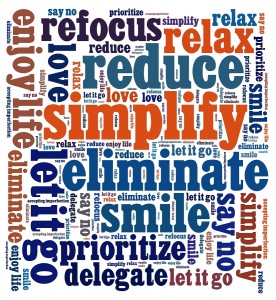
My birthday is Ground Hog’s Eve (Feb 1st). That means I get a do-over for whatever New Year’s Resolutions I haven’t followed through with. I get to make new resolutions for what I want to change before my next birthday. But this year I decided not to make resolutions. I decided to set intentions instead.
Resolutions too often include words like “don’t, won’t or never.” Intentions are focused on the future and can be stated in the present tense every day. After my morning meditation, I frequently set an intention to be grounded and focused throughout my day.
Intentions can become habits. A habit is defined as “an addictive behavior that is hard to give up” but an addiction does not need to be viewed negatively. For example, I am addicted to my grandchildren. The more time I spend with them the more time I want to spend with them.
What would happen if I became addicted to new habits? To become addicted, the first thing I need to do is to explore how I will benefit from my new habit. In sales, we are taught that when we convey the benefit first, ask key questions that lead our prospect to reply “yes” or to nod their head affirmatively, the close will take care of itself.
In December I set an intention to allow more time to get places and not squeeze one more thing in before getting out the door. Then I decided I couldn’t wait until January to put this into action because rushing to get out the door was stressing me out and negatively affecting everyone around me.
It isn’t an intention anymore; it’s a new habit. The benefit of allowing myself more time to get places and get out the door on time is that I don’t feel stressed about forgetting something important or anxious about being late. I am more grounded and focused throughout my day.
Habits create different types of energy. Good habits create positive energy that flows. “Bad” habits create problems like clutter and disorganization; a stagnation of energy, productivity and efficiency.
As a Home Organizer I look for the cause of the clutter and chaos in a space and often I see it is because of “bad” habits like not processing junk mail or not breaking down cardboard boxes when they are empty. When I am finished with a client, I make recommendations to help them to create new habits that will keep the clutter from re-accumulating and will maintain the serenity that organization has created.
One of the biggest challenges in life is to walk your walk and talk your talk. I intend to do that starting now and not wait until New Year’s Eve or Ground Hog’s Eve.
It’s common practice for Professional Organizers to advise their clients to use their vertical spaces. Oftentimes, rooms are so jam packed with furniture and your 4 walls are like, hey…look up here…there’s all this great space! Take a picture of each of your walls and really see how much space is being underutilized.
Now, close your eyes and think of the magnetic surfaces in your home, like appliances, file cabinets and bathroom cabinets. You use their interiors for food, files and toiletries respectively, but what about their exteriors? Aha! They offer vertical spaces too! Remember learning your alphabet with those magnetic block letters and using your refrigerator as a surface for organizing words or to document your trips with
fun magnets? Bingo!
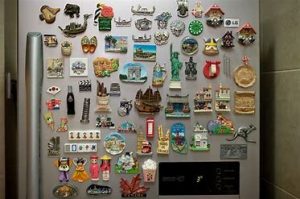
No, I’m not going to tell you to use those spaces. Besides, anyone with a Stainless-Steel refrigerator knows that they can’t use the front. Plus, I don’t want them to get cluttered up!
I first became intrigued by the idea of using metal surfaces for storage from a product named Grundtal (oh, those names!) from Ikea. It is a set of three magnetic spice tins. Designed to show what’s inside with a clear top, I thought of all the things that they could store aside from spices. There are the paper clips for your office, beads for crafters, and nails for your tool area.
So sure, there are magnet boards that you can buy to put such items on, but how about getting creative and creating one of your own! Try some of these other applications to get your stuff off surfaces and up on the wall!
Metal Serving Trays – Head to flea markets and garage sales, even thrift stores to look for these. To know for sure that they are magnetic, simply keep a small magnet in your pocket or purse and test it out. Spray paint your treasure in a color that you love and hang it up! Another idea is to frame the tray and use a colorful scrapbooking paper on the surface or wrap the tray taut in fabric!
Baking Sheets – I know what you are thinking…baking sheets are aluminum and not magnetic. True, however, with a coat of magnetic paint, it instantly becomes a magnet board! You take a regular cookie sheet, coat it with magnetic paint (available in a spray can) and it instantly becomes a magnet board!
Disclaimer: I have not tried the magnetic paint spray, so I’m not sure if it works. Reviews are mixed as to its magnetizing success.
The possibilities are endless with ideas of how to use these items for storage. Try them in:
…Your Entryway – using some magnetic caddies in various sizes for your sunglasses, your wallet, and a magnetic hook for your keys.
…Your Kitchen – using a small magnetic caddy for pens and note paper, invitations to parties (think one board for each family member) and of course for the above-mentioned spices in the Grundtal containers.
…Your Office – for inspirational pictures and quotes, your to do list, and small office supplies again in the Grundtal containers or ones like it.
…Your Bathroom – Listen up ladies! Look on Pinterest and use the search term “magnetic makeup organizers” and you’ll see a booming trend of using trays to hold makeup items vertical…genius! Glue those small disc magnets (from your local craft store) onto the back of products like powders, blushes and eyeshadows. For items like mascara, eyeliner and brushes, attach a small magnetic cup and store them there.
There is a myriad of other possibilities. Where would this work for you in your home?
“Where did all this stuff come from anyway? How did it all fit in here in the first place? I can’t believe how long this is taking and how many boxes we have! AAAaahhhh!!!!”
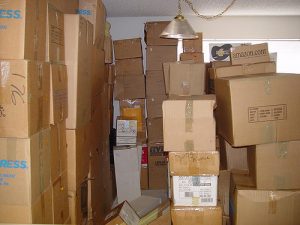
Well, it’s true. When we pull everything out of its storage space, we can see the volume of what we really have. And, for those things that haven’t been seen or touched in years: much of it is astonishing.
“Cans of hairspray? Wait. I haven’t bought hairspray in a can in at least 2…uh, 5…oh, I don’t know – better throw that out. How did these shoes get back here? Man, they’re dusty. And sort of misshapen. Well, okay very misshapen. Nevermind. Out! And, wait. Do we really have 6 new containers of black pepper? Six? I had no idea. This will last us forever!”
You are moving into a new home. Whether larger or smaller than your last, it’s an opportunity to get organized – right from the start! Here are 6 spaces to set up when you move in so you can get and stay organized:
Spice Storage: There are so many options for organizing spices that there is really no reason you need to fight to find what you need, have bottles and jars falling out onto you as you reach behind, or repurchase multiples of what you already have. 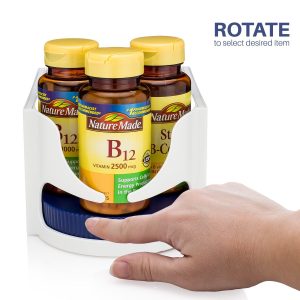
Pantry: DIY or go the extra mile and get pro-installation. A pantry organizing system will be a delight to your family today and a great selling point tomorrow.
Under Sinks: Either in the kitchen or bathrooms, under sink storage will make ALL the difference. Enjoy the control and say goodbye to yucky under-sink messes!
Shoes: The struggle is real. First decide where you want to store them (By the entryway? In a closet? Under the bed? In the garage?) Then, reign them in.
Bedroom Closets: If you are renting a home, you may want to save money and purchase some temporary solutions that you can take with you when you move out. For homeowners, installing built-ins is the way to go.
Storage Area: Before you go building columns and walls of heavy boxes stacked one atop another; stop and think. This is what got you into the last mess of storage chaos. Is there room for some shelving? Is there ceiling or wall space to be taken advantage of?
When Laura Kelleher saw a Facebook contest to win a room makeover, she didn’t realize the full effect of uploading a photo of her messy playroom. The contest was the first annual ‘Home Makeover Facebook Contest’ run by NAPO-GPC as a way to celebrate January as GO Month, or ‘Get Organized Month,’ in order to offer encouragement to people to start the New Year off with less clutter, less stress, and more clarity. After being selected as one of five finalists, the Kelleher family was selected as the 2017 winner.
Laura and her husband Tom, of Horsham, PA, live in a quiet suburban neighborhood with their three active children. The playroom, which is the first visible space upon entering the house, is a hub of creativity and imagination, particularly for the two older boys, ages 6 and 10, who build with Legos, collect dinosaurs, decorate the room with their artwork, and have a large collection of cars, trucks and collectibles. Then there is their 10-month-old baby sister who is just starting to explore the world of her big brothers. Getting the playroom organized was becoming an urgent need with stray Lego pieces within their baby sister’s reach.
The overarching goal for organizing the room was based on the fact that both of their sons are autistic. The lack of a clear system for the boys to access their toys and art projects created stress and an inability to function smoothly at home. Although both Tom and Laura knew their boys would respond well to systems and order, the project was too overwhelming for them to tackle on their own.
So on March 31, eight organizers from NAPO-GPC volunteered their time and talents to plunge into the Kelleher’s playroom. After clearing the room of all toys, books, and games, the professional organizers assembled five IKEA shelving units, sorted and categorized the vast variety of toys, and then brought it all together into a beautiful, well-ordered system. Laura and Tom worked alongside the team making decisions and securing the units to the wall. When completed, there was an entire section devoted to Legos, a bookcase for all craft items and books, and bins specifically dedicated to toddler toys.
The team completed the makeover in under five hours and then they waited for the boys to arrive home from school. It was like a surprise party and Christmas rolled into one! Now the brothers could rediscover their treasures and everything had a place! Bins were labeled and lids protected against the dangers of small pieces. No longer a stress zone, the family could enjoy the playroom as intended.
Click on the above title to learn more about the featured author.
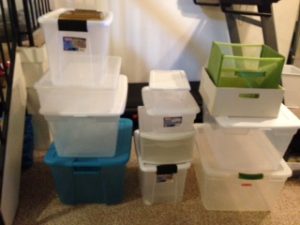 Whenever I do a workshop, I am invariably asked if you have to be born with an organizing gene. Although my answer to this question is no, I do think that all of us have gifts in different areas of life, and hence, we can all learn from each other.
Whenever I do a workshop, I am invariably asked if you have to be born with an organizing gene. Although my answer to this question is no, I do think that all of us have gifts in different areas of life, and hence, we can all learn from each other.
One of the tips that I always give my clients, workshop attendees, or anyone else who has a question about organizing is NOT to buy any containers until you see what you need. Until you know what you are going to keep after sorting and purging (this includes donating, recycling, shredding, and discarding), how would you know what size container to buy, or, if you even need one? You always want to make sure it is the right size, color, and that it will fit the space.
More often than not, there will be containers left after you’ve gone through the sorting and purging steps. You would be surprised at how many you thought you needed and bought, so use those containers first. No doubt they will work if you find you need them for other items you kept to store.
Do yourself and your wallet a favor and don’t spend the time buying something that you may not need. If you do buy something and don’t use it, are you going to remember where you put the receipt? If you find the receipt, you are going to have to spend time returning the item to the store. Wouldn’t you rather spend your time and money on what you really want?
Rather than buying the product first and then trying to see if it works for what you need, figure out your need first and then decide on the solution. When was the last time an inanimate object like a basket or plastic storage container organized you?
Click on the title above to learn more about the featured author.